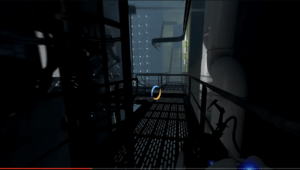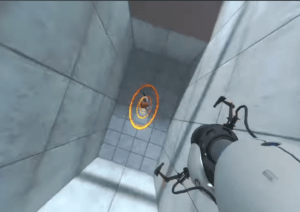Portal 2 is a puzzle game, playable on console or PC, and created by Valve in 2011. While it doesn’t have a particular audience, the game’s environment and characters inform perhaps a slightly more mature audience (teenagers and upwards). Puzzles mainly consist of creating pairs of portals that allow the player to move themselves, and specific other objects, through 3-dimensional spaces to destinations that they could not otherwise reach. Portal 2’s mechanics immerse the player in the game by providing them with a first-person perspective that makes the environment feel more real, while also providing unique challenges to figuring out the structure of levels that might have been more obvious from a free-camera, top-down, or third-person perspective.
Portal 2’s main types of fun are challenge – figuring out how to get to the end of the level in each case – as well as narrative: throughout the course of the game, you learn more about the mysterious facility you’ve been found in and the experiments that went on, as well as more about the motivations of the AI characters, GLaDOS and Wheatley. Portal 2’s titular mechanic – the portals – are an interesting case in puzzle games: whereas many puzzle games have a set number of actions (for instance, flip a switch or slide a slider), Portal’s portal placements are in theory continuous – there isn’t a single exact location you must place the portals, though generally there is a correct order of regions to place the portals. Despite this semi-rigid solution to each puzzle, the illusion of continuous action in most levels gives the experience a more fluid feel, as if you are actually a character in a free-roaming world; it ultimately gives the player more agency in the game. This experience is enhanced by Portal’s first-person mechanic. Unlike in many puzzles, where you’re able to see most to all of the available level mechanics due to the side/top view and third-person perspective, in Portal the first-person perspective adds another layer of difficulty to solving each puzzle. Areas that you want to access may be unreachable from your point of view without undergoing extra steps; or more generally, comprehending the level is more difficult when as a first-person player, you can only see part of it at a time.

The mechanics of the portal, as well as the physics as a whole, add more to the immersive gameplay. All objects obey simple physics (falling, etc.), but in addition, the portal has its own physics, such as speed preservation, which feels smooth when integrated with gameplay (and in fact is key to solving some puzzles that involve building up sufficient speed with portal loops). Combined with the other dynamic aspects of the environment, such as the bouncy gels and moving platforms, Portal 2 generates a world that is familiar to our own, while still including the physics-breaking mechanics (portals) that make the game what it is, while doing so in a way that doesn’t make the inclusion of these sci-fi objects feel artificial or out of place.

Ultimately, between the portal mechanics, the first-person perspective, and the semi-free action space, Portal 2 uses its mechanics effectively to make the narrative and gameplay more immersive for the player.




